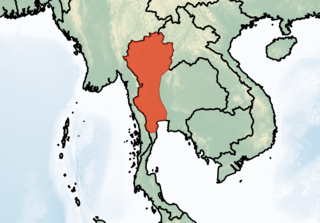
Burkholderia is a genus of Pseudomonadota whose pathogenic members include the Burkholderia cepacia complex, which attacks humans and Burkholderia mallei, responsible for glanders, a disease that occurs mostly in horses and related animals; Burkholderia pseudomallei, causative agent of melioidosis; and Burkholderia cepacia, an important pathogen of pulmonary infections in people with cystic fibrosis (CF). Burkholderia species is also found in marine environments. S.I. Paul et al. (2021) isolated and characterized Burkholderia cepacia from marine sponges of the Saint Martin's Island of the Bay of Bengal, Bangladesh.

Burkholderia thailandensis is a nonfermenting motile, Gram-negative bacillus that occurs naturally in soil. It is closely related to Burkholderia pseudomallei, but unlike B. pseudomallei, it only rarely causes disease in humans or animals. The lethal inoculum is approximately 1000 times higher than for B. pseudomallei. It is usually distinguished from B. pseudomallei by its ability to assimilate arabinose. Other differences between these species include lipopolysaccharide composition, colony morphology, and differences in metabolism.
Orthogonius thailandensis is a species of ground beetle in the subfamily Orthogoniinae. It was described by Tian & Deuve in 2006.
Weissella thailandensis is a species of Gram-positive bacteria. It is a homofermentative, sphere-shaped lactic acid bacteria. Its type strain is FS61-1T. Its genome has been sequenced.
"Candidatus Bartonella thailandensis" is a candidatus bacteria from the genus of Bartonella which was isolated in Thailand.
Serixia is a genus of longhorn beetles of the subfamily Lamiinae, containing the following species:
Miccolamia thailandensis is a species of beetle in the family Cerambycidae. It was described by Breuning and Chujo in 1966. It is known from Thailand.
Serixia buruensis is a species of beetle in the family Cerambycidae. It was described by Stephan von Breuning in 1958.
Serixia cinereotomentosa is a species of beetle in the family Cerambycidae. It was described by Stephan von Breuning in 1958.
Serixia novaebritanniae is a species of beetle in the family Cerambycidae. It was described by Stephan von Breuning in 1958.
Serixia nilghirica is a species of beetle in the family Cerambycidae. It was described by Stephan von Breuning in 1963.
Serixia longicornis is a species of beetle in the family Cerambycidae. It was described by Francis Polkinghorne Pascoe in 1858.
Serixia prolata is a species of beetle in the family Cerambycidae. It was described by Francis Polkinghorne Pascoe in 1858.
Serixia sedata is a species of beetle in the family Cerambycidae. It was described by Francis Polkinghorne Pascoe in 1862.
Serixia phaeoptera is a species of beetle in the family Cerambycidae. It was described by Per Olof Christopher Aurivillius in 1927.
Serixia nigroapicalis is a species of long horn beetle in the family Cerambycidae. It was described by Per Olof Christopher Aurivillius in 1927. This species is also part of the genus Serixia, order Coleoptera, class Insecta, phylum Arthropoda, and kingdom Animalia. These beetles can drill into wood and cause damage to live wood.
Serixia atritarsis is a species of beetle in the family Cerambycidae. It was described by Maurice Pic in 1929.
Serixia inconspicua is a species of beetle in the family Cerambycidae. It was described by Gardiner in 1936.
Listeria thailandensis is a species of bacteria. It is a Gram-positive, facultatively anaerobic, non-motile, non-spore-forming bacillus. It is non-pathogenic and non-hemolytic. It was isolated from a fried chicken sample from Thailand. The species was first proposed in 2019, and the species name refers to the country from which it was first isolated.

The Thailand horseshoe bat is a horseshoe bat endemic to northern Thailand.


